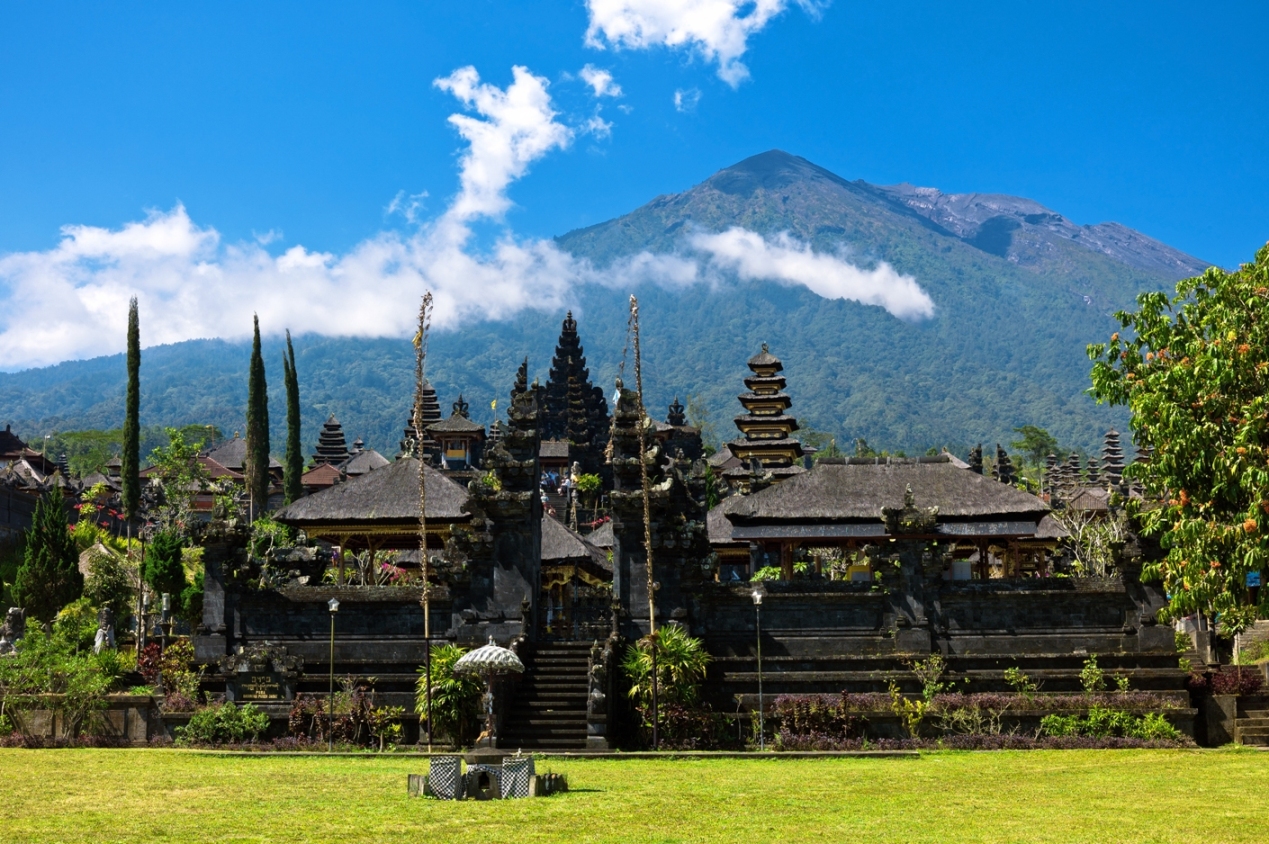Bali is part of a volcanic belt that stretches from Sumatra through Java and Bali to the Banda Sea. At 3,014 metres high, Gunung (Mount) Agung is Bali’s tallest and holiest mountain, its resplendent summit dominating much of the island. It is not surprising, therefore, that it is the dwelling place of the gods, with Pura Besakih, the island’s largest and most important Hindu temple located on its slopes and attracting both pilgrims and tourists. The Balinese treat this volcano with the greatest respect and even sleep with their heads facing in its direction. Temple shrines are dedicated to its spirit, offerings and cremation mounds are formed in its shape, and water from its sacred springs is the holiest and most sought after for temple rites. In March 1963, after lying dormant for 120 years, Gunung Agung erupted catastrophically and with such violence that the top 100 metres was blown apart. The earth rumbled and shook and putrid black smoke shot into the air, accompanied by deafening explosions and blinding white flashes. For more than 50 years now, this sleeping monster has been at peace, presenting a challenging and fulfilling experience for mountain lovers and trekkers.
Bali’s most visited mountain is Gunung Batur, which rests within the gigantic caldera of an extinct volcano measuring 11 kilometres in diameter. The caldera is reminiscent of a huge soup bowl with a serrated lip, a floor half covered in water – Danau (Lake) Batur, and a set of volcanic cones – the volatile mass of Mt Batur – budding in the centre. Danau Batur is Bali’s largest freshwater lake; it is the source of the rivers and springs for the entire eastern half of Bali, and irrigates most of the island’s fertile rice fields. At 1,717 metres high, Gunung Batur is by no means Bali’s highest volcano, but it is Bali’s second most sacred mountain after Gunung Agung, and has erupted more than 20 times during the last two centuries. Tourists flock to the locality, known as Kintamani, to enjoy an Indonesian buffet lunch in one of the many restaurants that sit on the ancient crater rim, offering spectacular views of the mountain and the lake. Also positioned on the rim of the caldera is Pura Ulun Danu Batur, Bali’s the second most important temple, dedicated to Dewi Danu, goddess of lakes and rivers. The temple was originally situated at the foot of the volcano but was destroyed in 1926 by a violent eruption and subsequently rebuilt on the rim. The upper cone of Gunung Batur can be climbed and descended in a few hours. Upon reaching the top, while you relish the beautiful aerial view of the lake and neighbouring mountains, your guide will prepare a unique breakfast of baked bananas and hardboiled eggs cooked to perfection in the natural heat of the volcano. After the descent, the hot springs on the shore of Danau Batur are perfect for easing aching limbs.
Gunung Batukaru in the Tabanan Regency is the island’s second highest peak and Western Bali’s axis mundi, defining the ‘kaja-kelod’, mountain-sea orientation of the architecture and rites. Located in an area that boasts the greatest biological diversity in Bali, its higher alpine slopes are filled with mountain streams, ferns, wildflowers, creepers and orchids, as well as the rare, black, leaf-eating monkey, small forest deer, butterflies, flying lizards, the landak (porcupine) and the lubak (mongoose). The area is also a birdwatchers’ paradise. Here, local guides lead visitors on anything from gentle hikes through the food forests to challenging treks to the 2,276-metre summit. The breathtaking view from the top extends across all of Bali’s nine regencies. On a clear day, the central and eastern volcanoes make a dramatic appearance to create a backdrop to the stage. High on the slopes of Gunung Batukaru is Pura Luhur Batukaru, the ‘Lofty Stone Coconut Shell Temple,’ which venerates the deities of mountains and lakes, and was the ancestral temple for the royal family of Tabanan, whose descendants still maintain the shrines today. It is well worth visiting this atmospheric, mystical, and deeply spiritual place, and pausing for a while to contemplate or meditate.
If you wish to trek any of these mountains, or visit the mountain-temples or the areas in which they are located, InterContinental Bali Resort’s unique brand concept ‘In the Know,’ is proud to offer insider destination tips. Treks and excursions can be arranged through the Resort’s concierge.

